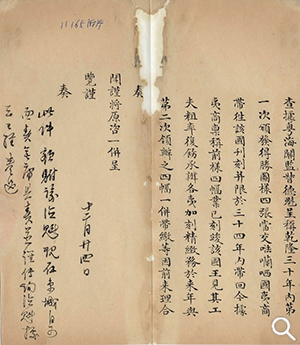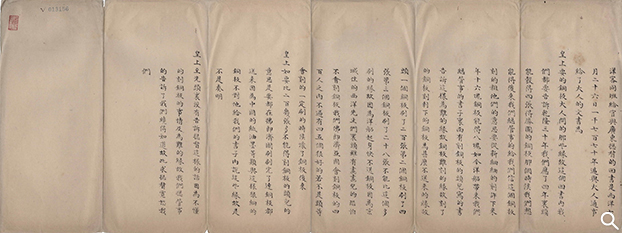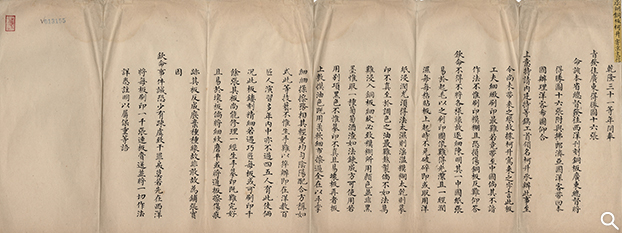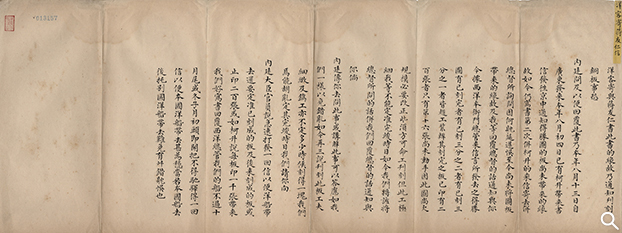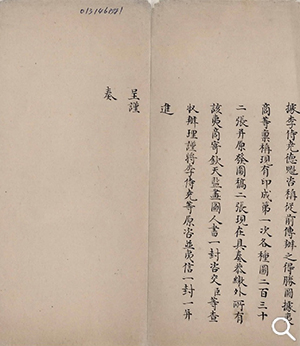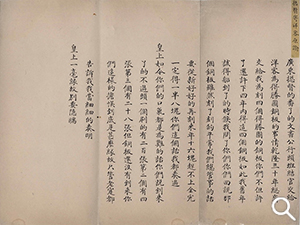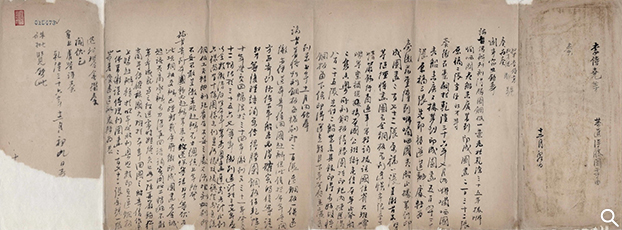Presented by Yang Tingzhang, Governor-general of Guangdong and Guangxi, and Fang Tiyu
Superintendent of the Guangdong Customs.
September 15, 1765.
22 cm × 126 cm 12 folds
On the 26th day of the 5th month in the 30th year of his reign (July 13, 1765), Emperor Qianlong issued an edict calling for Friars Giuseppe Castiglione, Jean-Denis Attiret (1702-1768) and Father Jgnatius Sickeltart (1708-1780) of the Society of Jesus, as well as the Augustinian father Joannes Damasceuns Salusti (?-1781) of the Sacred Congregation for the Propagation of the Faith to draw the first batch of four illustrations of the Victory in the Pacification of Dzungars and Muslims in preparation for copperplate engraving and printing by European craftsmen. On the 16th day of the 6th month (August 2), the Workshops of the Imperial Household Department presented the four sketches, a letter to Italy, the imperial edict and its Italian and Latin translations for review by the Emperor, who then instructed the Grand Council to send the materials to Guangdong at the earliest time, with an Express Delivery Warrant issued by the Ministry of War, to Guangdong, which arrived on the 10th day of the 7th month (August 25). Intended as a report on how the assignment had been attended to, this palace memorial was jointly presented by Governorgeneral Yang Tingzhang (1689-1771) of Guangdong and Guangxi and Superintendent Fang Tiyu (1735-?) of the Guangdong Customs on the 1st day of the 8th month (September 15, 1765). It shows that the officials in Guangdong had had no clue as to which European country would accept the order. It was through the Chinese Factory merchants that they consulted the General Manager of the French East India Company. At the same time, the French Jesuit father Louis Joseph Lefèbvre (1767- 1835) continued to lobby the officials who knew Governor-general Yang well, claiming French craftsmen’s superior engraving skills. The order was thus sent to France, with the expectation that four copperplates would be shipped back in the 34th year (1769) of the Qianlong reign. Considering the risks of maritime transport, Governor-general Yang and Superintendent Fang suggested in the memorial that two copies of the sketches be made and sent under separate cover, which was turned down by the Qianlong emperor in his rescript, “Why? One copy should do.” (Zhou Wei-qiang)
Presented by Dekui
Superintendent of the Guangdong Customs
November 28, 1769.
26.7 cm × 123 cm 10 folds (main text)
26.4 cm × 22.8 cm 2 folds (appendix)
After the first batch of four sketches reached France, Marquis de Marigny (1727-1784), then the President of the Royal Academy of Painting, was put in charge of supervising the engraving, and Charles- Nicolas Cochin (1715-1790) was assigned as the head engraver. The remaining twelve sketches reached France in July, 1767. By November of 1768, the French engraver had finished the first four engraved copperplates.
The year 1769 was the deadline for the delivery of the first batch of the copperplates and the prints. However, the Chinese side did not receive any by the end of year. Having consulted the Factory merchant on the status of the first batch, Superintendent Dekui of the Guangdong Customs received the following message:
The first four copperplate engravings of the Victory in the Pacification of Dzungars and Muslims were scheduled for delivery and presentation by 1769. They have in fact been completed, and should have been shipped. However, upon review by the King of France, the craftsmanship was deemed unsatisfactory. Since these engravings are commissioned by the Heavenly Empire, the engraver should have attended to the project with the utmost care. The King has therefore instructed all those involved to exert their best efforts to achieve absolute refinement. As a result, they have failed to deliver the copperplates and prints. The four copperplate engravings will be delivered next year, along with the four copperplates of the second batch. It is guaranteed that the delivery will not be delayed.
Immediately Dekui submitted the message in the form of a zicheng communication to the Grand Council.
A zicheng was an official correspondence to another office of the same or a higher ranking. Affixed on the first and last pages of the communication is the official seal, with inscriptions rendered in Chinese and Manchu scripts, of the Duli Guangdongsheng Yanhai Dengchu Maoyi Shuiwu Hubu Fensi (Office of International Trade Duties for the Province of Guangdong and Adjacent Coastal Areas, Ministry of Finance), which is the full name of the Guangdong Customs. (Zhou Wei-qiang)
Qianlong Reign
26.4 cm × 70.2 cm 6 folds
Upon receiving the first shipment of copperplate prints, Governorgeneral Li Shiyao was so unhappy with the delay that he commanded the Factory merchant to ask the French trader for truth. On the 5th day of the 6th month in the 35th year of the Qianlong reign (July 26, 1770), the French trader in Canton gave detailed accounts for the delayed delivery of the copperplates and prints, which were translated into Chinese.
The following is the response from the French trader: 200 prints were made from the first copperplate, 4 from the second and 28 from the third. However, to accommodate the French vessel’s scheduled departure, there was no time to print more copies. Further, considering that those foreign painters in the Capital are not capable of engraving, the copperplates were not delivered, either. Among the four hundred some engravers in France, only four or five are accomplished. The copperplates must be engraved by the most skilled craftsmen; otherwise, they would be damaged when taken to the printing press. It would therefore be impossible should the Emperor require more than 200 copies. What the Head Engraver in mind is that the printing be executed in France, as the paper and inks made in China are unfit for the print job. When completed, both the prints and the copperplates will be returned. Such are the explanatory notes he provided in his letter. Shall the Emperor be informed of these developments?
In the document the French trader reiterated the meticulousness required of engraving, and the Head Engraver he referred to was Charles-Nicolas Cochin. (Zhou Wei-qiang)
Translated by Michel Benoist and Jean-Joseph Marie Amiot
September 22, 1770
267 cm × 67.8 cm 6 folds
After Li Shiyao expressed his unhappiness with the French trader’s delayed delivery of the copperplates and prints, a mémoire by the French engraver Charles-Nicolas Cochin was presented to the Qing court by officials in Guangdong on the 4th day of the 8th month in the 35th year of the Qianlong reign, which was forwarded by the Grand Council to the French Jesuits Michel Benoist (1715-1774) and Jean-Joseph Marie Amiot (1718-1793) for translation. Cochin said in the document that the craftsmanship of copperplate engraving and printing was very demanding, that paper made in China was unfit for the print job and that only French paper could be used. He also pointed out that the inks for copperplate printing, made from grape pomace, must be carefully prepared so that they could be applied to the engraved fine lines evenly and properly. The application of the inks to the copperplates was vital, noted Cochin, to a successful print job; however, only four or five craftsmen in France possessed the necessary skills. With all these factors taken into account, he felt that they must attend to the project with the utmost care. That it took so much time was what had caused the delayed delivery. Cochin suggested that 1,000 prints be made from each copperplate, which would be shipped together back to China. He also promised that he would attach detailed notes on the making of copperplate prints. (Zhou Wei-qiang)
Translated by Michel Benoist and Jean-Joseph Marie Amiot
October 1, 1770
26.6 cm × 67.8 cm 6 folds
Posted by a French trader from Guangdong to Beijing on the 13th day of the 8th month in the 35th year of the Qianlong reign, the letter dealt with the status of the engraving and printing of the Victory in the Pacification of Dzungars and Muslims. The addressee Michel Benoist was expected respond to whatever question the Qing court might have on the progress of the project. When this letter reached Beijing, the Jesuits Michel Benoist and Father Joseph-Marie Amiot were instructed by the Grand Council to translate it into Chinese. Michel Benoist was a native of France, who came to China in 1744, and was most noted for the waterworks he constructed at the Yuanmingyuan Garden and for the production of the Huangyu Quantu (Map of the Chinese Empire and Neighboring Territories). In the letter the French trader asked Michel Benoist to approach the Head of the Imperial Household Department to specify the number of copies, 200 or 1,000, the French craftsmen were required to make from each of the copperplates, so that he could report to the French Prime Minister. He also wished to receive an official response by the end of the 10th month and the beginning of the 11th when the French vessel was scheduled for departure. Upon reading the letter, Emperor Qianlong ordered that 200 prints be made from each copperplate, and that both the prints and copperplates be returned upon completion, but not the paper and inks. Between 1773 and 1774, Benoist was also held accountable for the reprint in Beijing of the Victory in the Pacification of Dzungars and Muslims. (Zhou Wei-qiang)
Presented by Li Shiyao, Governor-general of Guangdong and Guangxi, and Dekui
Superintendent of the Guangdong Customs
October 23, 1770
26.4 cm × 170.8 cm 14 folds (main text) Attachment 1: Grand Council report to the Throne. 26.4 cm × 23.3 cm 2 folds (attachment 1: a copy to the Grand Council) Attachment 2: Governor-general Li Shiyao’s instruction to the French General Manager. 26.3 cm × 35.4 cm 3 folds (attachment 2: Viceroy to foreign traders)
On the 5th day of the 9th month in the 35th year of the Qianlong reign, Governor-general Li Shiyao of Guangdong and Guangxi as well as Superintendent Dekui of the Guangdong Customs jointly filed a communication with the Grand Council, reporting on the arrival of the first batch of copperplate engravings and a number of sketches, and on the delayed delivery of other copperplates and prints. They stated that the French vessel had brought back a total of 232 copperplate prints, including 200 copies of “Storming of the Camp at Gädän-Ola”, 4 copies of “The Battle of Arcul” and 28 copies of the “Receiving the Surrender of Yili,” and that the copperplate for “The Great Victory of Qurman” required further refinement, hence no printed copy was made. Two sketches were returned as well. As the quantity of the shipment did not meet the requirement, Li Shiyao and Dekui commanded the Factory merchant Pan Zhengcheng (1714-1788) to enquire. According to the Chief Manager of the French East India Company in Canton, a letter from France had the following to say, “Engraving is a very demanding skill. Only four or five engravers can do the job. A mistake made in the process may result in a complete remake. Any imperfection in the prints would render them impossible for delivery.” In other words, they could thus turn out this many copies. Considering that Chinese paper and inks might not be fit for making the copperplate prints, the French then expected that the illustrator at the Astronomy and Calendar Board would specify the number of prints required, so that printing materials could be prepared. In the mean time, Li Shiyao and Dekui ordered the Chinese Factory merchant to instruct the French Chief Manager in Canton to write home immediately to ask the engravers to catch up with the schedule. Having received the communication from Li Shiyao and Dekui, the Grand Council promptly delivered the sketches, copperplates and prints, along with the French letter to the illustrator at the Astronomy and Calendar Board and the Factory merchant’s letter to the French trader, for imperial review. (Zhou Wei-qiang)
Presented by Li Shiyao
Governor-general of Guangdong and Guangxi, and Dekui
Superintendent of the Guangdong Customs
September 1, 1771
26.7 cm × 109.8 cm 9 folds
On the 14th day of the 11th month in the 35th year (1770) of the Qianlong reign, Li Shiyao and Dekui received an imperial decree through Fu Longan, Minister of Works and Head of the Imperial Household Department, with the instructions that 200 prints from each engraving were to be made, that the copperplates and the prints were to be shipped back together and that there was no need to have such printing materials as paper and inks prepared. The Chinese trader Pan Zhengcheng was immediately summoned by Li Shiyao and Dekui, and was given a letter prompting the engravers in Paris to speed up and the instruction to negotiate with the French Chief Manager in Canton, who was expected to embark on a journey home to deliver the message. On the 26th day of the same month the two submitted a memorial to Emperor Qianlong. Under much pressure from the Chinese side, the French finally managed to deliver in August of 1771 the second shipment, which was made up of 543 prints, 5 galley proofs and 3 sketches. Li Shiyao and Dekui soon filed a communication with the Grand Council, along with a copy to the Imperial Workshops, reporting that the lot would be delivered with the New Year offerings from the Guangdong Customs. According to the archival records of the Imperial Household Department, the lot arrived on the 19th day of the 11th month of that year, and was stored in the Qixianggong Palace (today’s Taijidian Pavilion) in the Forbidden City. (Zhou Wei-qiang)
Presented by Li Shiyao, Governor-general of Guangdong and Guangxi, and Dekui Superintendent of the Guangdong Customs Memorial dated November 24, 1771 Imperial rescript dated January 23, 1772
25.7 cm × 69 cm 6 folds
On the 18th day of the 10th month in the 36th year of the Qianlong reign, Li Shiyao and Dekui submitted a palace memorial on the receipt of the third shipment of 272 copperplate prints and one sketch. The archival records of Imperial Household Department show that the lot arrived on the 9th day of the 12th month, comprising 15 copies of “The Battle of Arcul,” 58 copies of “Receiving the surrender of Yili,” 67 copies of “The Battle of Oroi-jalatu,” 66 copies of “A Victory Banquet Given by the Emperor for the Distinguished Officers and Soldiers” and 66 copies of “The Great Victory of Qurman,” which were all stored in the Qixianggong Palace in the Forbidden City. As the quantity of the prints did not meet the requirement, Governor-general Li Shiyao rebuked the Factory merchant, who in turn consulted the French trader. The French Chief Manager then reported, based on a letter from France, that two batches of copperplate prints were scheduled for delivery in 1771, and that the other prints were of poor quality, so the copperplates had to be retained. (Zhou Wei-qiang)
[Text] LI Shiyao et al. Presenting the "Engravings of Victory" The 9th Day of the 12th Month of Qianlong's 36th Year Your humble servant LI Shiyao, and Your humble servant Dekui. With our highest respect.
Please allow us to report the progress of the making of the "Engravings of Victory". In 1770, a French ship came to Guangzhou and brought two model drawings and two hundred and thirty two prints. We have already reported this. In 1771, another French ship came to Guangzhou and brought three model drawings and five hundred and forty three prints. We have already sent them to the Imperial Household Department. Subsequently another French ship had brought one model drawings and two hundred and seventy two prints. Your humble servants inquired them about their shortage of prints and copperplates, and also about the delays. According to their management, they have received a message from home, telling them they had only two ships to Guangzhou this year. Among the printed copies, 815 copies are good enough to be shipped separately via two ships. The copperplates stay in France so they can print more copies to compensate for the shortage which will be shipped using the next ship. Last year, the Emperor instructed them to make two hundred copies for each copperplate and the copperplates shall be shipped with the printed copies. They will follow your order; however, the letter still takes time to reach France. According to them, the letter will reach France this winter.
Your humble servant inquired them several times, about these questions: "The first lot of four model drawings were shipped in 1765, and expected to be completed in 1769. The other twelve model drawings were shipped in 1766, and expected to be completed from 1770 to 1772. By 1772, they should have completed all the works. How could they only ship only six pictures with the rest ten of them nowhere to be seen? Can you tell us why?" They replied, "The copperplates are very fine. One false move and they have to engrave another plate. If a print is not good enough; it must be discarded. They are not lazy. When the Emperor's edict finally reached France, they will do their best to have everything ready without delay." Your humble servant knew this copperplate engraving project has taken many years. There is still shortage in their works. I am afraid they are being lazy so I inquired again. They always reply the workmanship really takes much time and communications always take too long. We urged our merchants to inform French merchants this job's importance and asked them to mail their home country using the latest ship to France. They shall give up the full number of prints and printing plates as well when their ship comes to Guangzhou next year. Now, please allow us to present the 272 printed copies and one model drawing to the Imperial Workshop and allow up to file the memorial for the Emperor's viewing.
The Emperor's Reply: I got it! The 9th Day of the 12th Month of Qianlong's 36th Year
Presented by Li Shiyao, Governor-general of Guangdong and Guangxi, and Dekui
Superintendent of the Guangdong Customs
September 27, 1772
26.5 cm × 70.8 cm 14 folds
In 1772, Li Shiyao and Dekui filed yet another report with the Grand Council on the fourth and fifth shipments of the copperplate engravings. The fourth shipment, arrived on the 28th day of the 7th month, consisting of 275 prints, 2 sketches and 3 copperplates. Dispatched for the Capital on September 1, this lot was a little late reaching the Imperial Household Department. According to the archival records of the Department, it was not until the 22nd day of the 12th month when the shipment was received, including 77 prints of “The Battle of Arcul,” 100 prints of the “Lifting of the Siege at the Black Water River,” 98 prints of “The Emperor is Presented with Prisoners from the Pacification of the Muslim Tribes” and one sketch for “The Emperor is presented with Prisoners from the Pacification of the Muslim Tribes,” as well as one copperplate for “The Battle of Arcul,” one copperplate for “The Battle of Oroi-jalatu,” one copperplate for the “Lifting of the Siege at the Black Water River” and another gold-framed copy of “The Emperor is presented with Prisoners from the Pacification of the Muslim Tribes.” They were taken in by a palace eunuch named Hu Shijie, to be presented for imperial review.
The fifth lot of 185 prints and 4 copperplates reached Canton on the 19th day of the 8th month. In addition, the shipment also included seven crates of books on copperplate engraving as well as paper, inks and printing tools. The archival records of the Imperial Household Department show that the items received on the 20th day of the 11th month by a clerk named Fuqing and others were 77 copies of “The Battle of Arcul,” 100 copies of the “Lifting of the Siege at the Black Water River,” 3 copies of “The Great Victory of Qurman,” 2 copies of “The Battle of Oroi-jalatu” and 3 copies of “A Victory Banquet Given by the Emperor for the Distinguished Officers and Soldiers,” as well as one copperplate for the “Receiving the surrender of Yili,” one copperplate for “The Great Victory of Qurman” and one copperplate for the “A Victory Banquet Given by the Emperor for the Distinguished Officers and Soldiers.” They were to be presented by the palace eunuch Hu Shining for imperial review. (Zhou Wei-qiang)
Presented by Li Shiyao, Governor-general of Guangdong and Guangxi
October 5, 1774
22.4 cm × 71.4 cm 7 folds
On the 1st day of the 9th month in the 39th year of the Qianlong reigh, Governor-general Li Shiyao of Guangdong and Guangxi, submitted a palace memorial on the receipt of the seventh shipment from France, which was made up of 229 prints, one copperplate, one sketch and four galley proofs. He reported that the French in the previous six shipments had already delivered 2151 prints, 10 copperplates, 11 sketches and 4 galley proofs. With the present shipment counted, a total of 2,380 prints and 11 copperplates had been received, and 820 prints and 5 copperplates were to be forwarded by the French. Afterwards, the eighth shipment arrived in the 9th month in the 40th year (1775) of the Qianlong reign, and the ninth shipment the 8th month of the 41st year (1776), respectively. On the 20th day in the 9th month of 42nd year (1777) Governor Li Zhiying of Guangdong filed a communication with the Grand Council, reporting that the last shipment from France of 149 prints, one copperplate and two sketches were on their way to the Imperial Workshops. Undertaken by French craftsmen, the copperplate engraving project which had lasted for twelve years was finally concluded. (Zhou Wei-qiang)
Qianlong reign, Qing dynasty
25.1 cm × 230 cm 20 folds
For five times did Emperor Qianlong award the copperplate prints of the Victory in the Pacification of Dzungars and Muslims to different individuals, and the list in the Museum’s collection is a tally of the recipients. In the first time, 18 sets of prints were given to the Emperor’s sons and grandsons, as well as Manchu princes of the first rank, members of the Grand Council, Mongol princes of the first rank and princes of the second and third ranks. In the second, 13 Manchu princes of the first, second and third ranks, 8 governors-general and 3 governors received the prints. In the third, 36 sets were delivered to the Emperor’s grandsons and great grandsons, as well as ministers, governors, directors-general of river conservation, generals, commanders-in-chief, superintending officials and counselors. In the fourth, the recipients were meritorious officials and their descendents, as well as those who had contributed to the compilation of military annals. In the fifth and last time, the Emperor presented the prints to four book collectors who had donated their own holdings to the enterprise of editing the Siku Quanshu (Complete Library of the Four Treasuries). A total of 101 sets of copperplate prints were given. (Zhou Wei-qiang)



